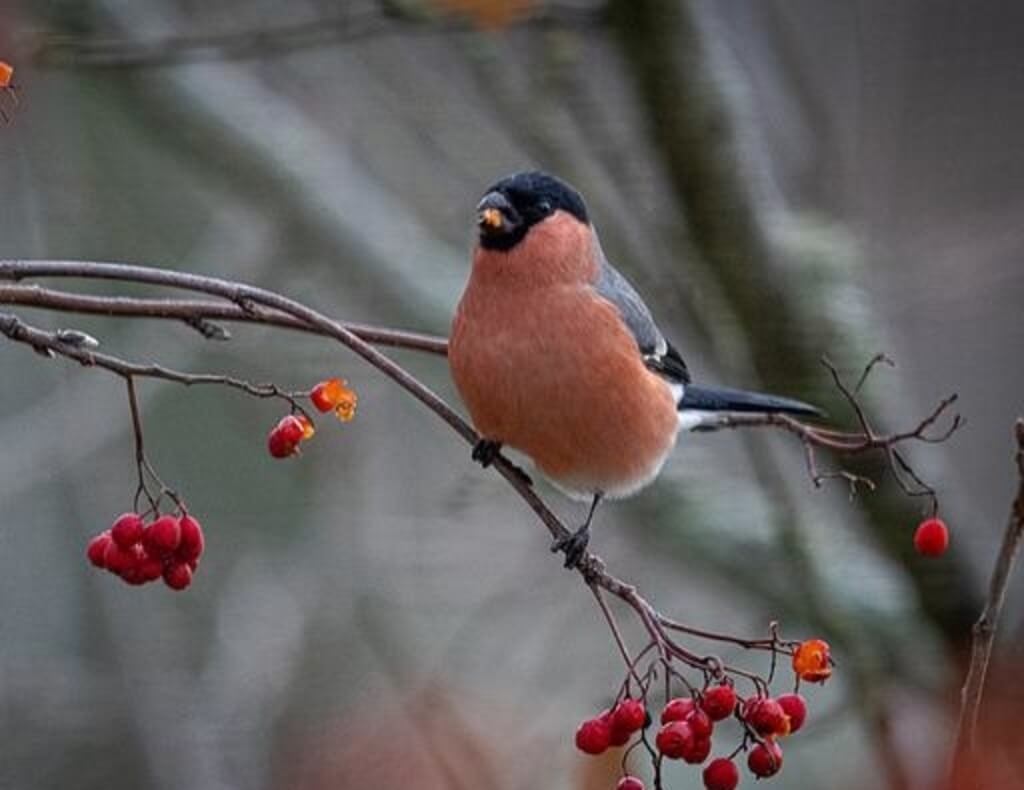Step into the fascinating world of avian dining with our guide to “18 Birds That Eat Mountain Ash Berries.” In this exploration, we introduce you to a diverse assembly of birds known for their affinity for these iconic berries.
Join us as we uncover the unique culinary preferences and ecological roles of these feathered diners, providing a glimpse into the intricate connections between birds and the abundant clusters of Mountain Ash berries.
Table of Contents
- 1 Key Takeaways
- 2 Identification of American Mountain Ash Tree
- 3 Types of Birds That Eat Mountain Ash Berries
- 3.1 American Robin
- 3.2 Baltimore Oriole
- 3.3 Brown Thrasher
- 3.4 Eastern Bluebird
- 3.5 Gray Catbird
- 3.6 Veery
- 3.7 Cedar Waxwing
- 3.8 Northern Cardinal
- 3.9 Purple Finch
- 3.10 Dark-eyed Junco
- 3.11 Black-capped Chickadee
- 3.12 White-breasted Nuthatch
- 3.13 Tufted Titmouse
- 3.14 Blue Jay
- 3.15 Red-headed Woodpecker
- 3.16 White-throated Sparrow
- 3.17 Pine Grosbeak
- 3.18 Evening Grosbeak
- 4 Author
Key Takeaways
- Diverse Avian Species: Explore the fascinating world of birds that feast on mountain ash berries, including a variety of species with unique characteristics.
- Ecological Importance: Discover the crucial role these birds play in the ecosystem by aiding in seed dispersal, contributing to the regeneration of mountain ash trees.
- Seasonal Feeding Patterns: Gain insights into the migratory and seasonal habits of these birds, as they rely on mountain ash berries for sustenance during specific times of the year.
- Colorful Visitors: Appreciate the vibrant and diverse plumage of the featured birds, adding a visual spectacle to the mountain ash landscape.
- Conservation Implications: Understand the potential impact of environmental changes on the availability of mountain ash berries, emphasizing the need for conservation efforts to protect both the birds and their habitat.
Identification of American Mountain Ash Tree
The American Mountain Ash (Sorbus americana) also known as the Rowan Tree, a captivating deciduous tree, stands as a testament to nature’s artistry. Renowned for its aesthetic appeal, this small tree graces landscapes with an exquisite display throughout the seasons.
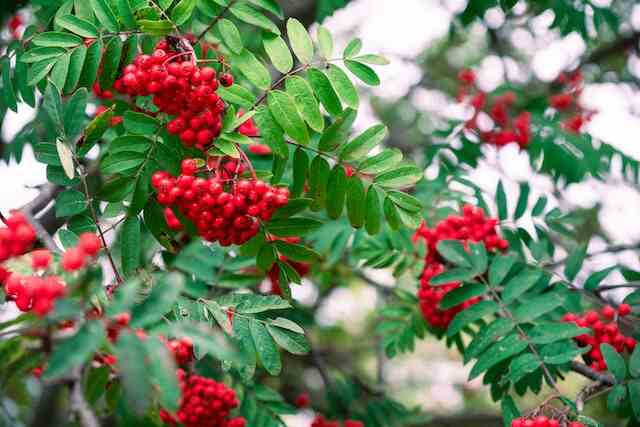
Appearance
In spring, the American Mountain Ash unfurls showy white flowers, creating a breathtaking spectacle. As summer transitions to fall, the tree adorns itself in warm yellow foliage, casting a golden glow across the surroundings. The pièce de résistance arrives in late fall to early winter when the tree showcases fiery red and orange berry clusters, a visual feast for observers.
Size and Structure
Typically reaching heights between 15 to 30 feet, with a corresponding spread of 15 to 25 feet, the American Mountain Ash exhibits an elegant and well-proportioned stature. Its branching structure enhances its overall aesthetic, making it a focal point in various landscapes.
Ecological Significance
Beyond its visual allure, the American Mountain Ash plays a vital role in supporting local ecosystems. The fragrant flowers attract insects and caterpillars, forming a crucial link in the food chain.
These, in turn, draw insectivorous birds, establishing a harmonious ecological balance. Notably, the vibrant berry clusters become a seasonal banquet for many bird species, with the American Robin and Cedar Waxwing among its enthusiastic patrons.
Types of Birds That Eat Mountain Ash Berries
American Robin
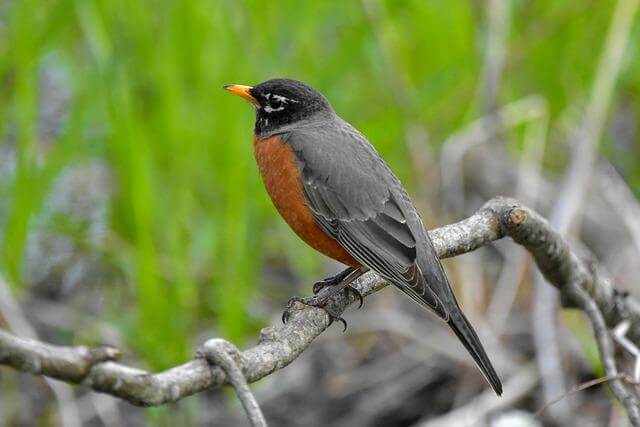
| Length | Weight | Wingspan | Scientific Name |
|---|---|---|---|
| Typically (9-11 inches) | 2.7-3 ounces | 12-16 inches | Turdus migratorius |
The American Robin, a familiar North American songbird, holds the distinction of being one of the most prevalent avian species across the United States. Its habitat spans from central Alaska to southern Mexico, covering a vast territory from the Atlantic to the Pacific coast.
Found in a range of environments, the American Robin thrives in coniferous and deciduous forests, as well as urban areas. Its adaptable nature allows it to make homes in diverse landscapes, contributing to its widespread presence.
Diet-wise, these robins are omnivores, consuming a varied menu that includes insects, fruits, and seeds. Notably, in late summer and fall, they exhibit a particular affinity for berries from the American Mountain Ash tree, forming a significant component of their diet during these seasons.
Baltimore Oriole
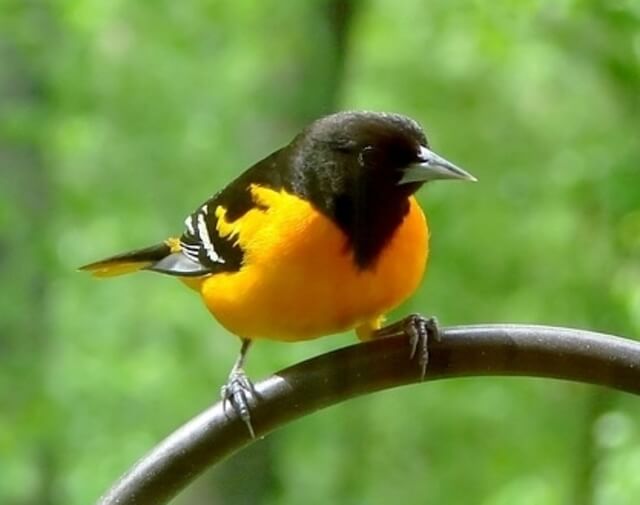
| Length | Weight | Wingspan | Scientific Name |
|---|---|---|---|
| 7-8 inches | 1 ounce | 9-12 inches | Icterus galbula |
The Baltimore Oriole, a vibrant songbird, graces North America with its striking plumage and melodious tunes. Their range extends from the eastern United States to Central America, creating a colorful presence across diverse landscapes.
These orioles favor various habitats, including open woodlands, gardens, and parks. Their distinctive orange and black coloring adds a splash of brilliance to the foliage they inhabit.
Diet-wise, Baltimore Orioles are primarily insectivores but also enjoy nectar from flowers and, notably, have an affinity for fruit, including berries. In late summer and fall, the Baltimore Oriole is known to include berries from the American Mountain Ash tree in its diet, contributing to the ecological interplay between these birds and the tree.
Brown Thrasher
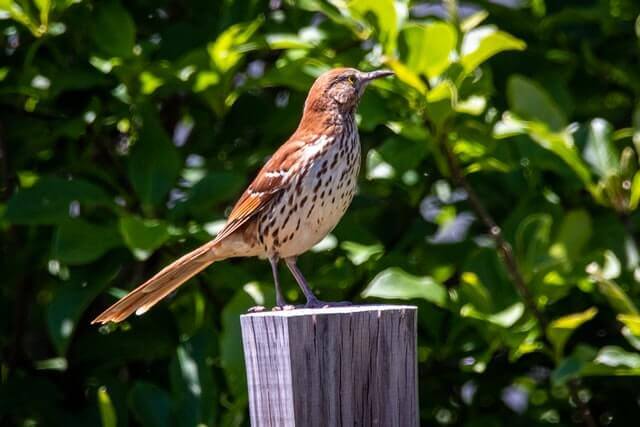
| Length | Weight | Wingspan | Scientific Name |
|---|---|---|---|
| 11-12 inches | 2.5-3 ounces | 13 inches | Toxostoma rufum |
The Brown Thrasher, a skilled songster, graces North America with its distinctive song and elegant plumage. Its range spans from southern Canada to central Mexico, favoring shrubby and woodland habitats.
With an adaptable nature, the Brown Thrasher thrives in diverse landscapes, including thickets, gardens, and urban areas. Its striking brown plumage and speckled chest make it a delightful sight for bird enthusiasts.
Diet-wise, Brown Thrashers are omnivores, feeding on a variety of insects, berries, and small vertebrates. They exhibit a particular fondness for ground-dwelling insects, showcasing their resourceful foraging techniques. In late summer and fall, the Brown Thrasher is known to include berries from the American Mountain Ash tree in its diet, contributing to the ecological interplay between these birds and the tree.
Eastern Bluebird
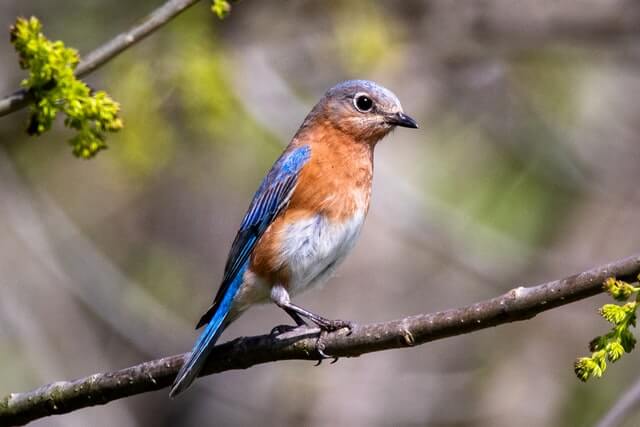
| Length | Weight | Wingspan | Scientific Name |
|---|---|---|---|
| 6.5-8 inches | 1 ounce | 9-12 inches | Sialia sialis |
The Eastern Bluebird, renowned for its striking blue plumage, graces North American landscapes from the eastern United States to Central America. Measuring 6.5 to 8 inches in length with a wingspan of 9 to 12 inches, these delicate birds, scientifically known as Sialia sialis, weigh around 1 ounce.
While primarily insectivores, Eastern Bluebirds exhibit a notable fondness for berries, with a particular affinity for those of the American Mountain Ash tree. This preference is driven by the berries’ nutritional richness, offering essential nutrients and energy.
The berries become a valuable dietary supplement, especially during the fall and winter months when the availability of insects diminishes. This dietary choice underscores the importance of Mountain Ash trees in supporting the Eastern Bluebird population and contributing to the bird’s overall health and vitality.
Gray Catbird
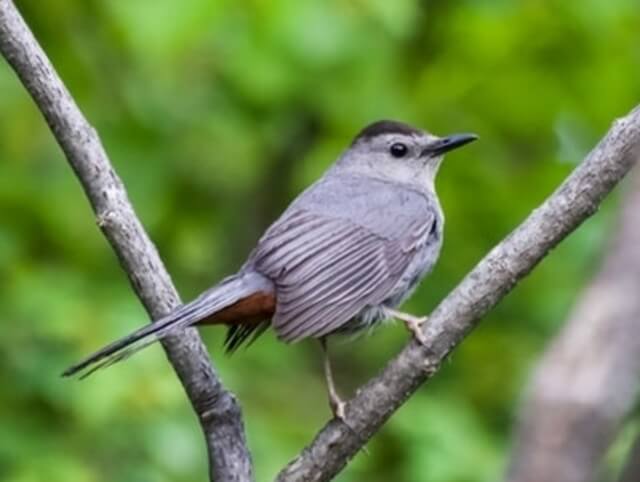
| Length | Weight | Wingspan | Scientific Name |
|---|---|---|---|
| 8-9 inches | 0.8-2 ounces | 9-12 inches | Dumetella carolinensis |
The Gray Catbird, an elusive songster with a mysterious allure, is a native of North America. Thriving in dense shrubbery and woodlands, their range extends from southern Canada to the Gulf of Mexico.
Distinguished by their slate-gray plumage and the subtle rust-colored patch beneath their tail, Gray Catbirds are often heard before they are seen. They prefer habitats with dense vegetation, showcasing an affinity for tangled thickets and garden shrubs.
As omnivores, Gray Catbirds have a diverse diet, including insects, berries, and fruit. In the late summer and fall, they develop a particular liking for the berries of the American Mountain Ash tree, contributing to the ecological dynamics of their habitat.
Veery
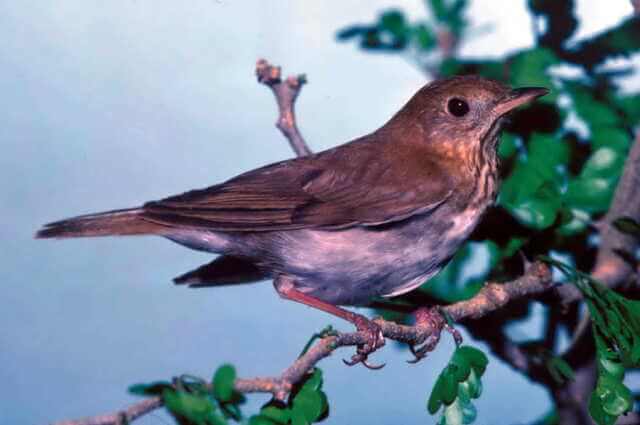
| Length | Weight | Wingspan | Scientific Name |
|---|---|---|---|
| 6-7 inches | 0.8-1 ounce | 11 inches | Catharus fuscescens |
The Veery, a charming thrush, graces the woodlands of North America with its ethereal song and subtle plumage. These birds are known for their preference for moist, shaded habitats and are found in deciduous and mixed forests.
Distinguished by their warm cinnamon-brown coloring and distinctive song, Veeries contribute to the melodic tapestry of the forest. They play a vital role in the ecosystem by foraging on insects, spiders, and fruits.
In late spring and summer, Veeries are known to include berries, including those from the American Mountain Ash tree, in their diet. The berries serve as a seasonal food source, adding diversity to their foraging habits and highlighting their ecological connection with this tree species.
Cedar Waxwing
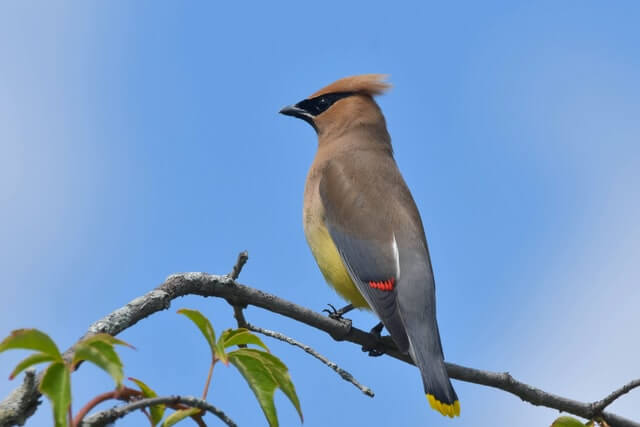
| Length | Weight | Wingspan | Scientific Name |
|---|---|---|---|
| 6.5-7 inches | 1 ounce | 11 inches | Bombycilla cedrorum |
The Cedar Waxwing, an elegant songbird with distinctive plumage, graces North America with its presence. Their range spans across the continent, from southern Canada to the northern regions of Central America.
These waxwings inhabit a variety of environments, including woodlands, orchards, and urban areas. Recognized for their sleek appearance and crested feathers, Cedar Waxwings bring a touch of sophistication to the landscapes they frequent.
Diet-wise, Cedar Waxwings are primarily frugivores, consuming a diet rich in fruit. Their penchant for berries, including those from the American Mountain Ash tree, marks them as key contributors to the ecosystem, dispersing seeds as they feed.
Northern Cardinal
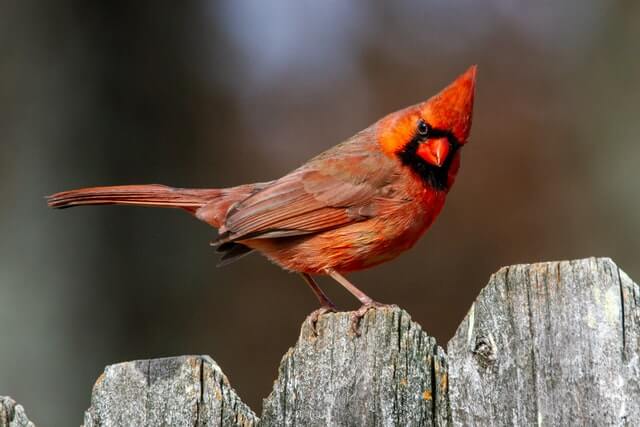
| Length | Weight | Wingspan | Scientific Name |
|---|---|---|---|
| 8-9 inches | 1.5-2.1 ounces | 10-12 inches | Cardinalis cardinalis |
The Northern Cardinal, an iconic symbol of North American birdlife, enchants observers with its striking red plumage and distinct crest. Flourishing in various habitats, from woodlands to urban areas, these birds are a familiar sight across the eastern and central United States.
Scientifically known as Cardinalis cardinalis, Northern Cardinals are primarily seed-eaters but exhibit an interesting preference for berries, including those of the American Mountain Ash tree. Their attraction to Mountain Ash berries is rooted in the nutritional benefits these fruits provide.
The energy-rich composition of Mountain Ash berries becomes especially vital for Northern Cardinals during seasons when other food sources are limited. This dietary choice not only underscores the bird’s adaptability but also highlights the vital role that Mountain Ash trees play in supporting the Northern Cardinal population and contributing to their overall health and well-being.
Purple Finch
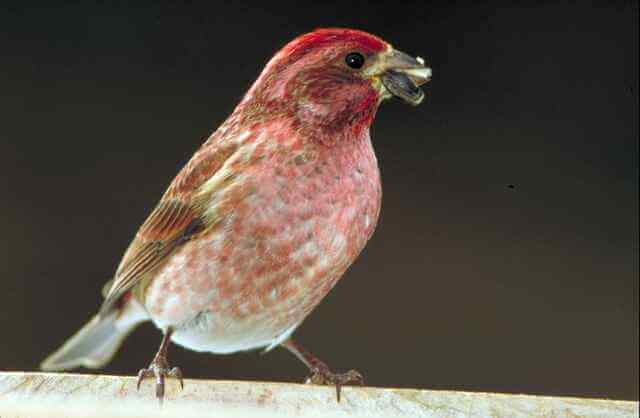
| Length | Weight | Wingspan | Scientific Name |
|---|---|---|---|
| 5-6 inches | 0.9-1.1 ounces | 9-10 inches | Haemorhous purpureus |
The Purple Finch, adorned in hues ranging from raspberry red to plum purple, graces North American landscapes with its vibrant presence. Commonly found in coniferous and mixed forests, these finches have a widespread distribution, spanning from the western United States to southern Mexico.
Scientifically known as Haemorhous purpureus, the Purple Finch is primarily seed-eating, with a penchant for small seeds and fruits. Among its favored delicacies are the berries of the American Mountain Ash tree.
The Purple Finch’s attraction to Mountain Ash berries is driven by the nutritional benefits they offer. Serving as a rich source of energy and essential nutrients, these berries become a valuable dietary supplement, particularly during seasons when other food sources are less abundant.
Dark-eyed Junco
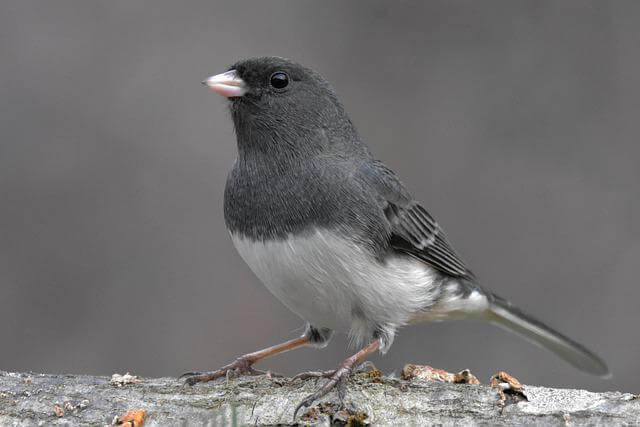
| Length | Weight | Wingspan | Scientific Name |
|---|---|---|---|
| 6-7 inches | 0.7-1 ounce | 8-10 inches | Junco hyemalis |
The Dark-eyed Junco, a modest yet charming member of the sparrow family, is known for its subtle grayish plumage and distinctive white belly. This adaptable bird finds its home in various habitats, including forests, parks, and even suburban areas, across North America.
Scientifically classified as Junco hyemalis, the Dark-eyed Junco primarily feeds on seeds, with a particular affinity for those scattered on the ground. This versatile bird showcases an additional taste for berries, including those of the American Mountain Ash tree.
The appeal of Mountain Ash berries to Dark-eyed Juncos lies in their availability and nutritional value. These berries offer a seasonal supplement to the bird’s predominantly seed-based diet, providing essential nutrients and energy.
Black-capped Chickadee
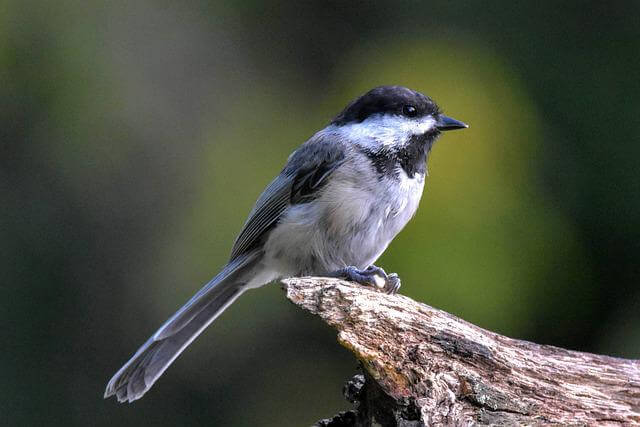
| Length | Weight | Wingspan | Scientific Name |
|---|---|---|---|
| 4.7-5.9 inches | 0.3-0.5 ounces | 6.3-8.3 inches | Poecile atricapillus |
The Black-capped Chickadee, a charming and energetic songbird, graces North American woodlands and backyard feeders with its distinctive black cap and cheeky personality. Found in a variety of habitats, from coniferous forests to urban gardens, these chickadees are prevalent across the northern regions of the continent.
Scientifically known as Poecile atricapillus, Black-capped Chickadees are primarily insectivores, but their diet expands to include seeds and berries, with a notable fondness for those of the American Mountain Ash tree.
The appeal of Mountain Ash berries to Black-capped Chickadees lies in their accessibility and nutritional value. These berries serve as a supplementary food source, offering essential nutrients and energy during the winter months when insect availability decreases.
White-breasted Nuthatch
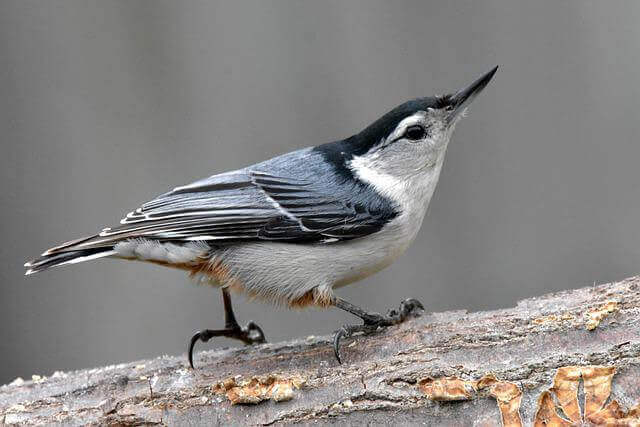
| Length | Weight | Wingspan | Scientific Name |
|---|---|---|---|
| 5.9-6.3 inches | 0.7-1.2 ounces | 7.9-10.6 inches | Sitta carolinensis |
The White-breasted Nuthatch, a charismatic acrobat of the bird world, delights observers with its distinctive head-down foraging antics. Thriving in deciduous woodlands and mixed forests across North America, these nuthatches bring both charm and utility to their ecosystems.
Scientifically known as Sitta carolinensis, the White-breasted Nuthatch is renowned for its insect-centric diet, foraging on tree trunks and branches in search of insects, spiders, and seeds. However, it also demonstrates a keen interest in the berries of the American Mountain Ash tree.
The appeal of Mountain Ash berries to White-breasted Nuthatches lies in their nutritional value. While these nuthatches are primarily insectivores, the berries provide a valuable source of additional nutrients and energy, particularly during times when insects are less abundant.
Tufted Titmouse
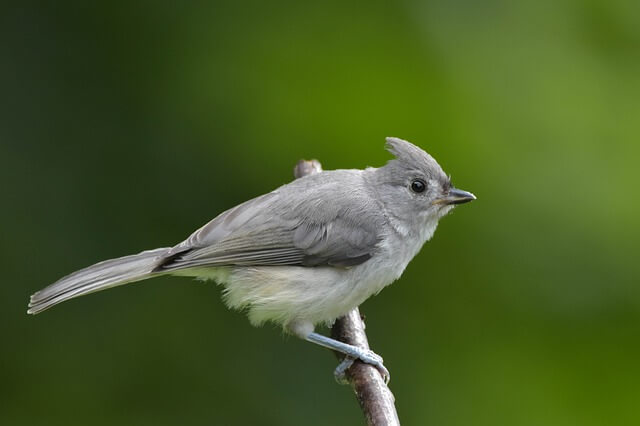
| Length | Weight | Wingspan | Scientific Name |
|---|---|---|---|
| 5.5-6.3 inches | 0.7-1.1 ounces | 7.1-10.2 inches | Baeolophus bicolor |
The Tufted Titmouse, with its distinctive gray plumage and fetching crest, is a familiar and lively character in the woodlands and suburban areas of North America. Found throughout the eastern and central regions of the United States, these small songbirds bring cheer to diverse environments.
Known by its scientific name Baeolophus bicolor, the Tufted Titmouse is primarily an insectivore, foraging for insects, spiders, and small seeds. In addition to its insect-focused diet, this titmouse exhibits an interest in berries, including those borne by the American Mountain Ash tree.
The Tufted Titmouse’s inclination towards Mountain Ash berries is rooted in their nutritional value. As a supplementary source of essential nutrients and energy, these berries contribute to the bird’s overall dietary variety.
Blue Jay
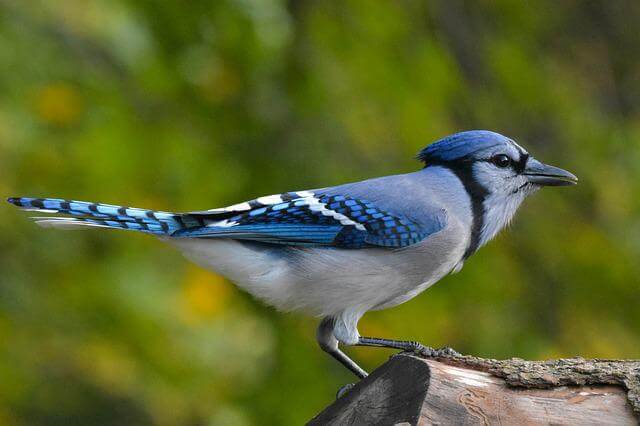
| Length | Weight | Wingspan | Scientific Name |
|---|---|---|---|
| 9-12 inches | 2.5-3.5 ounces | 13-17 inches | Cyanocitta cristata |
The Blue Jay, with its striking blue and white plumage and distinctive crest, adds a vibrant touch to North American landscapes. These intelligent and adaptable birds thrive in various habitats, from forests to urban areas, spanning across the eastern and central parts of the United States.
Scientifically known as Cyanocitta cristata, Blue Jays are omnivores, displaying a diverse diet that includes seeds, nuts, insects, and fruits. Among their culinary preferences are the berries of the American Mountain Ash tree.
The Blue Jay’s attraction to Mountain Ash berries is influenced by their availability and nutritional content. These berries, rich in energy and essential nutrients, become a significant component of the Blue Jay’s diet, especially during seasons when other food sources may be scarce.
Red-headed Woodpecker
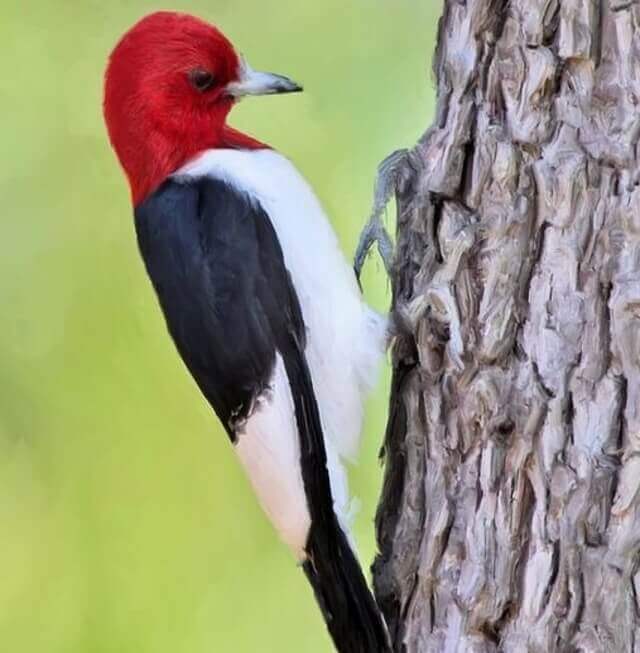
| Length | Weight | Wingspan | Scientific Name |
|---|---|---|---|
| 7.5-9.1 inches | 2-3.4 ounces | 16.1-18.1 inches | Melanerpes erythrocephalus |
The Red-headed Woodpecker, an avian marvel with striking crimson plumage and distinctively patterned wings, graces the woodlands and open habitats of North America. With a broad distribution from the Great Plains to the eastern United States, these woodpeckers are easily identifiable by their vibrant appearance.
Scientifically known as Melanerpes erythrocephalus, the Red-headed Woodpecker is a versatile forager, preying on insects, fruits, and nuts. Their diet is notably diverse, and they exhibit a keen interest in the berries of the American Mountain Ash tree.
The allure of Mountain Ash berries to the Red-headed Woodpecker lies in their abundance and nutritional value. Acting as a supplementary food source, these berries provide essential nutrients, especially during seasons when insect prey may be scarce.
White-throated Sparrow
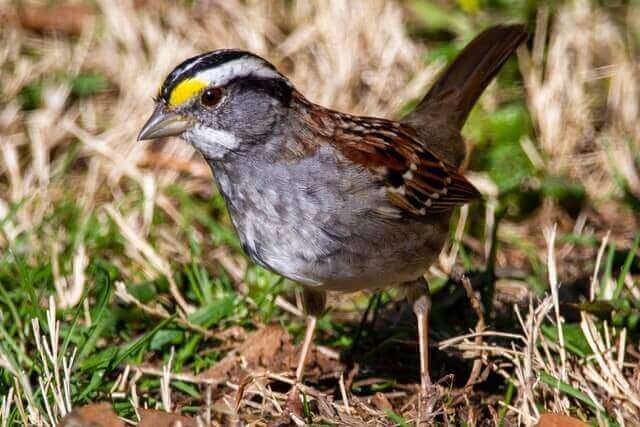
| Length | Weight | Wingspan | Scientific Name |
|---|---|---|---|
| 6.3-7.1 inches | 0.9-1.2 ounces | 8.7-9.8 inches | Zonotrichia albicollis |
The White-throated Sparrow, distinguished by its crisp black and white crown stripes and a distinctive white throat, graces North American woodlands and shrubby areas. With a habitat range extending from Canada to the central United States, these sparrows are a common and delightful presence in diverse ecosystems.
Scientifically known as Zonotrichia albicollis, the White-throated Sparrow primarily forages for seeds on the ground. However, their diet extends to include berries, and among these, the berries of the American Mountain Ash tree hold a notable appeal.
The White-throated Sparrow’s preference for Mountain Ash berries is tied to the fruit’s nutritional value. Laden with essential nutrients and energy, these berries become a valuable dietary supplement, especially during periods when insect and seed availability may fluctuate.
Pine Grosbeak
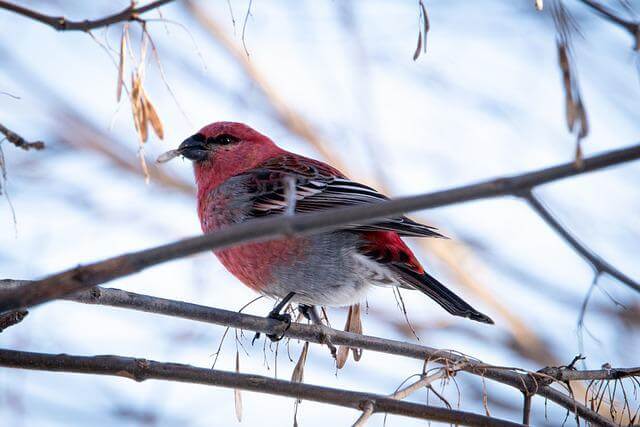
| Length | Weight | Wingspan | Scientific Name |
|---|---|---|---|
| 7.9-10.2 inches | 1.6-2.6 ounces | 13.8-15.8 inches | Pinicola enucleator |
The Pine Grosbeak, a robust and colorful finch species, graces the northern forests of North America with its distinctive appearance. With a widespread distribution from Alaska to the northeastern United States, these grosbeaks prefer coniferous habitats, where their vibrant plumage stands out against the evergreen backdrop.
Scientifically known as Pinicola enucleator, Pine Grosbeaks are primarily seed-eaters, demonstrating a particular affinity for the seeds and berries of coniferous trees, including those of the American Mountain Ash.
The attraction of Pine Grosbeaks to Mountain Ash berries is rooted in the nutritional benefits provided by these fruits. Serving as a rich source of energy and essential nutrients, these berries become a crucial component of the grosbeak’s diet, especially during the colder months when other food sources may be scarce.
Evening Grosbeak
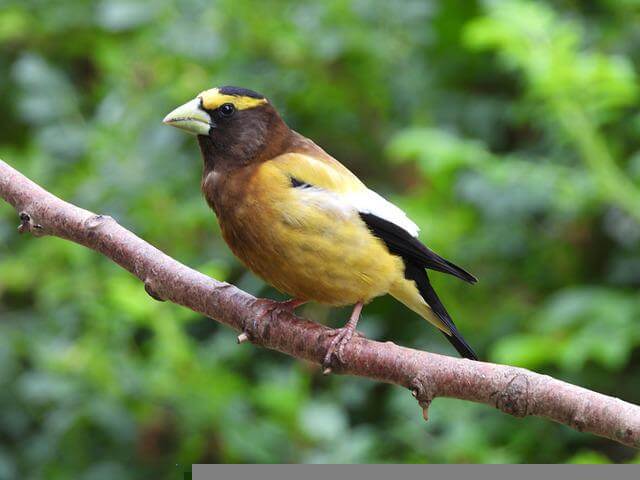
| Length | Weight | Wingspan | Scientific Name |
|---|---|---|---|
| 6.7-8.7 inches | 1.5-2.3 ounces | 11-13.8 inches | Coccothraustes vespertinus |
The Evening Grosbeak, a striking bird with vibrant yellow plumage and a distinctive massive beak, graces North American forests with its unique presence. Flourishing in coniferous and mixed woodlands, these grosbeaks are known for their nomadic movements, ranging from the western United States to the eastern parts of the continent.
Scientifically classified as Coccothraustes vespertinus, the Evening Grosbeak primarily feeds on seeds, with a particular affinity for those found in deciduous and coniferous trees. Notably, they are drawn to the berries of the American Mountain Ash tree.
The Evening Grosbeak’s attraction to Mountain Ash berries is rooted in their nutritional value. These berries serve as a crucial source of energy and essential nutrients, especially during seasons when other food sources may be limited.

